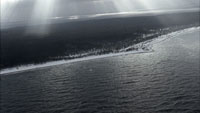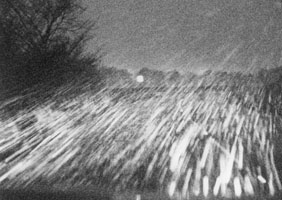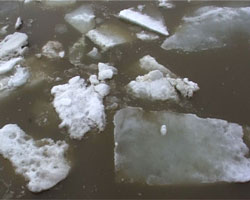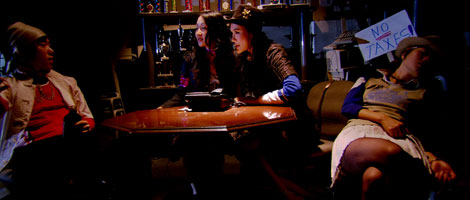26 – 28 FEBRUARY 2008
Strolling: about a collection
In conjunction with the show devoted to the work of Marie José Burki, we will be featuring a program of videos and artists' films, including Burki's early pieces, which were coproduced by the Center for Contemporary Images. There is one theme that surfaces again and again in Burki's art, the theme of strolling. It is the act that allows one's gaze to wander and construct a fictional story, an imaginative world through reverie. It is also the idea of shifting around forms, concepts and oneself in the end. In this shift the subject is wandering from himself; it is precisely when the body is in a situation where it needs to find its place that the latter notion dissolves. That aspiration to find where we belong propels us to move. To borrow Jean-Luc Nancy's remark, "I'm moving when I'm not where I am."1
The films making up this program are for the most part drawn from the Center for Contemporary Images' own collection, which boasts over 1700 titles at present. Thanks to this program of works, the public will have the chance to wander around this collection, the most important of its kind in Switzerland and available for viewing in our multimedia library.
1 Jean-Luc Nancy and Abbas Kiarostami, L'Evidence du film.
Tuesday, 26 February – 7 p.m.

Rosa Barba, Outwardly from Earth’s Center, 2007, 24 min.
The story of an endangered island. Its inhabitants are doing everything in their power to reverse their fate, fighting the elements to ensure that they indeed have a future on their bit of land. A story of local customs, beliefs and personal tragedies, a community's fear of seeing itself swept away by the forces of nature. As in her previous works, Rosa Barba doesn't respect chronology but rather attempts to compile a list of all the elements that play a role in a given situation. It's up to the viewer to create the link between the different parts in order to make the story coherent.
Jonah Freeman, The Franklin Abraham, 2003, 55 min.
An urban metaphor filmed inside a sprawling building. The camera wanders down endless corridors, offering us in a series of encounters the indifferent, voyeuristic point of view of a community marked by capitalism.
"The Franklin Abraham" is the outcome of an ambitious real estate project extending over 200 years. At the outset the project was a residential high-rise in a modern-rococo style that developed into a totally hybrid architectural monstrosity over time. A crucial detail worth bearing in mind, this real estate complex is a complete fabrication on the artist's part. The film that takes off from this project offers a subjective look at society today through the lives of the fictional people who supposedly use the building. The film's cinematographic structure is based on the sprawling nature of the building. In this micro-city viewers discover fragments of the private lives of a disillusioned teenager, a shy female civil servant meeting with a cynical Don Juan, or a gang that is squatting the building's underground floors.
Tuesday 26 February – 9 p.m.
Sophie Calle, Double Blind (No Sex Last Night), 1992, 76 min.
An intimate road movie across the United States that takes Sophie Calle and Greg Shepard in a Cadillac from New York to Las Vegas. The viewer follows the evolution of the two protagonist's relationship which leads to marriage.
Double Blind tells several stories in fact, that of Greg Shepard in the midst of a nervous breakdown, in love with another woman, and feeling that he's been drawn into the trip somewhat against his will. As for Sophie Calle, the artist decided on this journey, its final destination and one of its legs, a marriage in Las Vegas. The film falls within a perspective that verges on the documentary film, a documentary of private, intimate life since it is supposed to follow the development of a relationship that Calle hoped was a romantic one. But the story doesn't go that way. Very quickly she is made aware of what separates her from Shepard and the precariousness of their relationship, which, contrary to expectations, doesn't grow any deeper. They do not become close, although they share the same car and even the same bed at night. Their mornings when they rise are forever accompanied by Calle's unvarying assessment, "No sex last night."
Wednesday 27 February – 7 p.m.
Marie José Burki, Celui qui a vu passer les éléphants blancs, 1986, 11 min.
Several questions bearing on the moving image are tackled here, including space and the image, the length of a shot and narrative construction.
Burki questions the space of the image through the omnipresence of the world off-camera, which is figured by the recurrent use of windows and shots framed such that they cut off people's heads. The presence of a snail crossing the visual field also raises the notion of the length of a shot while the construction of a story with images, words and sounds is initially dissected in the first three quarters of the tape. The artist then demonstrates a narrative by elaborating a final mini-fiction whose denouement shows that narrative realism is but one convention among several. The violence of the images, which are borrowed from both (news) television and the movies (duels, chase sequences, armies in movement), is a metaphor of the violent constraints that cultural conventions impose on art.
Marie José Burki, Reading over and over, 1990, 10 min.
Directly connected to the expatriate experience, this piece deals with geography and history in that mythic place of immigration, New York.
Marie José Burki blends American prehistory, with its burden of a guilty conscience vis-à-vis the massacre of the Indians, the prewar Vienna of Musil's novel The Man without Qualities, with all that it represented for modern European thought, and finally her own views on New York. The artist manages to take a rather banal personal experience and transform it into a questioning of culture's clichés, a sensitive connecting of knowledge and nature, lightly underscoring the historic violence of passing from one state to another. The landscape, treated like an empty, neutral field, is an extremely powerful metaphor of the question of space.
Marie José Burki, Sometimes, Some of Them, Here, 2008, 30 min.
The latest of Marie José Burki's productions, this film plunges us into a societal problem that is very much in the news. Asylum seekers evoke the displacement that life's circumstances have forced upon them. A fragmented panorama of world geography takes shape in the viewer's mind.
Wednesday 27 February – 9 p.m.

Clemens Klopfenstein, Transes - Reiter auf dem toten Pferd, 1980-81, 87 min.
Description via a movie camera of that exhilarating moment of departure. Long sequences filmed from a car or train exercise a liberating fascination over the viewer.
The piece is a subjective voyage of the camera between trance and suffering that goes further than Geschichte der Nacht, a film that is often called a precursor of the work being done in the Dogma movement.
Artavazd Pelechian, Konetz (La Fin), 1992, 10 min.
Visual poem that observes the passengers of a train hurtling along that eventually enters a tunnel. Nothing other than the unity of place connects these men and women of every age and ethnicity. All of them are riding in the same railcar and the camera is along for the ride, too, framing the window, the passing landscape, the trees tossing whorls of shadows, quasi-abstract arabesques, until the train disappears into a tunnel.
Thursday 28 February – 7 p.m.
Pauline Julier, Outo Hiljaisuus, 2006, 9 min., sound: Xavier Lavorel

Observe the surrounding reality while appealing to that impalpable state, the uncanny. A loose, drifting attention, a long suspended moment in which the gaze can develop and time run its course.
Contrasting the different registers and image qualities makes a dialog among them possible, enables them to break free of their immediate, primary sense and move away from the simple transmission of information and knowledge to create something other than an interpretation. A woman comes forward. A dull, heavy sound is heard. Then comes a mirror, slowly. A little girl is seen playing, following the image of a red-haired woman in a tram. Everything is strange. The noise starts up once again. The woman continues walking, temporal punctuation, perhaps a measurement.
Enrique Fontanilles and Tadeus Pfeifer, Hundred Years and Ten Minutes, 1995, 10 min.
The camera glides along the Ganges in Benares, the Indian city where reality exceeds every illusion.
History's first film was publicly screened on 28 December 1895 in the Indian Room of the Grand Café along Paris's Boulevard des Capucines. Today India is the country that produces the most films. One hundred years after this first screening, ten minutes of unedited video are dedicated to this first film shot by the Lumière Brothers.
Ken Kobland, Arise! Walk Dog! Eat Donut!, 1999, 30 min.
Urban landscapes like the subways of New York and Berlin, which Kobland filmed 20 years earlier.
These views framed by Kobland's sympathetic and sardonic camera are emphasized by excerpts from a Russian ballet recounting the banality and despair that underlie routine.
Sebastian Diaz Morales, The Man With the Bag, 2004, 39 min.
A man walking in a deserted landscape, bearing a bag that contains all his possessions. He constantly trips on the same stone, avoids his fears and a sound that never materializes. Going beyond limits, he continues to move forward in the same direction.
This simple story, like a metaphor, includes part of the foundation of human existence. Viewers, finding themselves somewhere between the man and those who are pursuing him, share his fears and his paranoia. What is the man looking to flee? And what is the significance of the screen divided in two, which renders the vanishing point literally vanishing?
Thursday 28 February – 9 p.m.
Martijn Veldhoen, Public Spaces, 2006, 11min.
A look at the evolution of how public space is perceived. A space that has become threatening, no longer as safe as it once was.
Once public space was a clear concept, a kind of democratic medium, a place of free exchange open to all. Today things have changed. Thanks to systems of wireless communication, private space has come out of its own sphere and spread everywhere, reducing public space by as much as it has expanded. Nowadays public space has all the attributes of emptiness and draws those who can't have or don't want access to the globalized world. The narrator's tone is calm and contemplative. The world "Bombe" is written on a wall like graffiti. The camera lingers before a subway station, a railroad station and a market, all "guilty" places. Impossible to see "the usual suspects," but the sense of danger and feeling of paranoia exist. Time passes, unshaken, unmoved. An ill-fated future is drawing near.
Roman Signer, Action avec une mèche, 1990, 26 min. (a film by Peter Liechti)
From 11 September to 15 October 1989, Roman Signer laid down a fuse, which he allowed to burn out, from his birthplace in Appenzell to his current place of residence in St. Gall, i.e., a distance of some twenty kilometers.
At each point where two fuse ends meet, the advancing fire releases a quick pointed flame, then tranquilly continues on its way inside the flammable cord it is consuming. By passing constantly from the violence of the explosion to the imperceptible progress of the burning point inside the fuse, the artist reconstructs time and space. In these dimensions, which are nonetheless measurable with technical precision, Signer introduces an entirely new subjectivity. From extreme concentration to infinite extension. From instantaneous violence to a painful long stretch of time, "I'm fascinated to the highest degree by the alteration of a state. When a slow movement is suddenly reversed as is the case in an explosion, like the slow burning of the fuse and suddenly the burst of flame—it's really a piece of sculpture, a temporal sculpture, a combination of the extremely slow and the super fast." The sculpture "Aktion mit einer Zündschnur" (Action with a Fuse) isn't limited to expressing formally the theme of progress structuring space and time; Signer also sees the piece as a metaphor of travel and life that simply marches on.
Marina Abramovic & Ulay, The Lovers: Boat Emptying, Stream Entering, 1988, 31 min.
Marina Abramovic & Ulay decided to mark the breakup of their relationship with a performance. Starting off each from one end of the Great Wall of China, they reunite, embrace and separate, each going his or her separate way.
After walking for 90 days, the two met up in Er Lang Shan in Shaanxi Province. Their ceremony for making their final farewell reflects the rest of their work in common, which had always involved ritualized actions, mythology and Eastern thought. The performance was filmed by Murray Grigor for the BBC. The resulting film has yielded a documentary entitled "The Great Wall: Lovers at the Brink," which exists in a long and a short version. In this video, Abramovic offers her own take on the event.

General admission: 10.-
Reduced admission: 6.-
